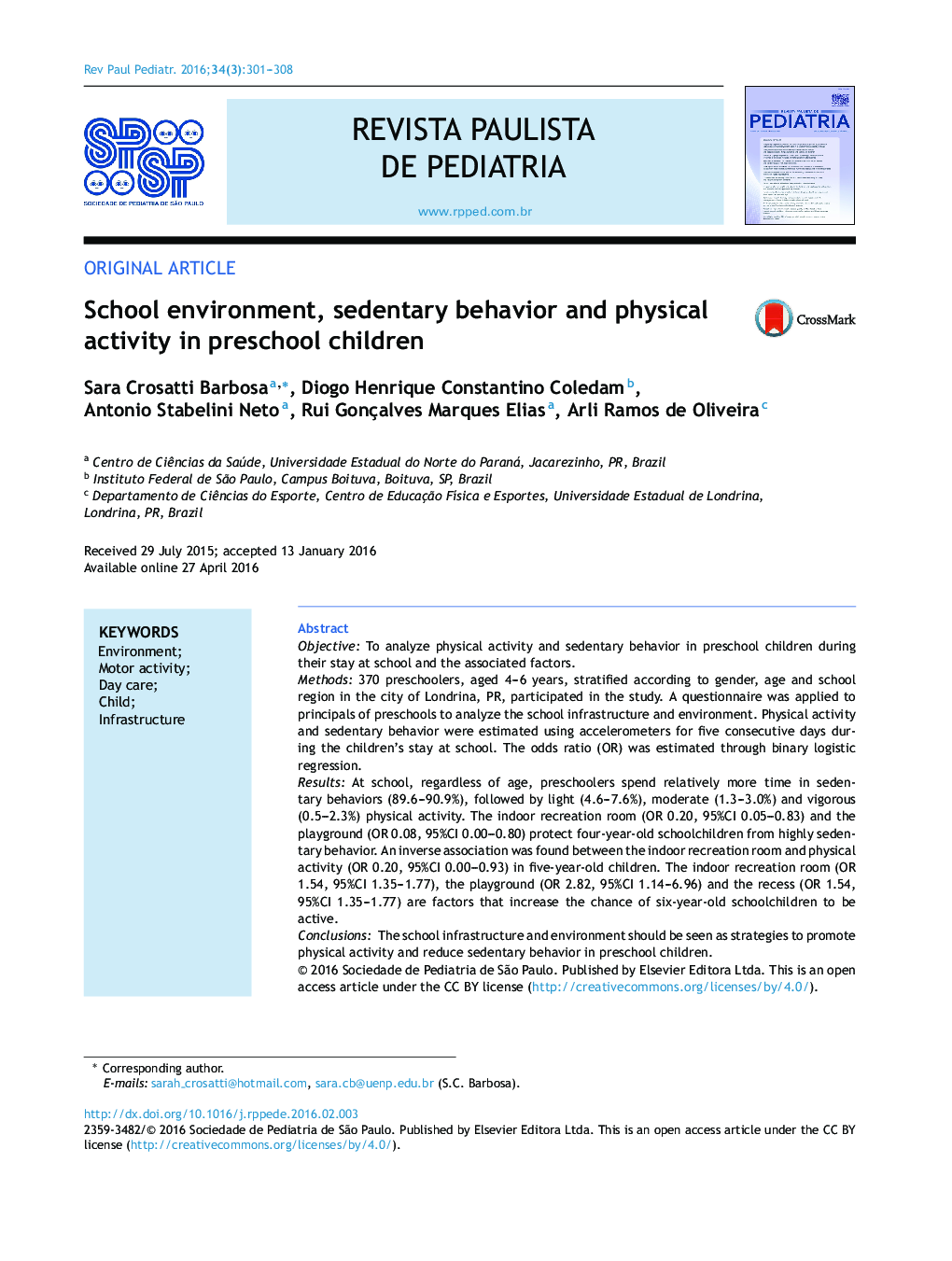| Article ID | Journal | Published Year | Pages | File Type |
|---|---|---|---|---|
| 4176108 | Revista Paulista de Pediatria (English Edition) | 2016 | 8 Pages |
ObjectiveTo analyze physical activity and sedentary behavior in preschool children during their stay at school and the associated factors.Methods370 preschoolers, aged 4–6 years, stratified according to gender, age and school region in the city of Londrina, PR, participated in the study. A questionnaire was applied to principals of preschools to analyze the school infrastructure and environment. Physical activity and sedentary behavior were estimated using accelerometers for five consecutive days during the children's stay at school. The odds ratio (OR) was estimated through binary logistic regression.ResultsAt school, regardless of age, preschoolers spend relatively more time in sedentary behaviors (89.6–90.9%), followed by light (4.6–7.6%), moderate (1.3–3.0%) and vigorous (0.5–2.3%) physical activity. The indoor recreation room (OR 0.20, 95%CI 0.05–0.83) and the playground (OR 0.08, 95%CI 0.00–0.80) protect four-year-old schoolchildren from highly sedentary behavior. An inverse association was found between the indoor recreation room and physical activity (OR 0.20, 95%CI 0.00–0.93) in five-year-old children. The indoor recreation room (OR 1.54, 95%CI 1.35–1.77), the playground (OR 2.82, 95%CI 1.14–6.96) and the recess (OR 1.54, 95%CI 1.35–1.77) are factors that increase the chance of six-year-old schoolchildren to be active.ConclusionsThe school infrastructure and environment should be seen as strategies to promote physical activity and reduce sedentary behavior in preschool children.
ResumoObjetivoAnalisar a atividade física e o comportamento sedentário de pré-escolares durante a permanência na escola e os fatores associados.MétodosParticiparam do estudo 370 pré-escolares de 4 a 6 anos, estratificados de acordo com sexo, idade e região da escola em Londrina (PR). Foi aplicado um questionário às diretoras das pré-escolas para analisar a infraestrutura e o ambiente escolar. A atividade física e o comportamento sedentário foram estimados com acelerômetros por cinco dias consecutivos durante a permanência na escola. A razão de chances (RC) foi estimada por meio da regressão logística binária.ResultadosNa escola, independentemente da idade, os pré-escolares permanecem relativamente mais tempo em comportamento sedentário (89,6%-90,9%), seguido de atividade física leve (4,6%-7,6%), moderada (1,3%-3%) e vigorosa (0,5%-2,3%). A sala de recreação interna (RC=0,20; IC95% 0,05-0,83) e o parque (RC=0,08; IC95% 0,00-0,80) protegem os alunos de 4 anos do comportamento sedentário elevado. Associação inversa foi encontrada entre sala de recreação interna e atividade física (RC=0,20; IC95% 0,00-0,93) nos escolares de 5 anos. Sala de recreação interna (RC=1,54; IC95% 1,35-1,77), parque (RC=2,82; IC95% 1,14-6,96) e recreio (RC=1,54; IC95% 1,35-1,77) são fatores que aumentam a chance dos escolares de 6 anos de serem ativos.ConclusõesA infraestrutura e o ambiente da escola devem ser considerados como estratégias para promover a atividade física e reduzir o comportamento sedentário em pré-escolares.
